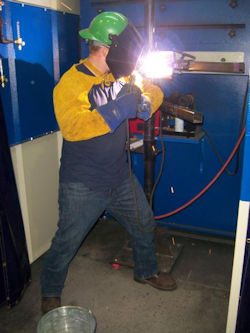Protection from Arc Welding Rays
Where the work permits, enclose the welder in an individual booth painted with a finish of low reflectivity such as zinc oxide (an important factor for absorbing ultraviolet radiations), or enclose the welding station with noncombustible screens similarly painted.
- Booths and screens must permit the circulation of air at the floor level.
- Protect workers or other persons adjacent to the welding areas from the rays by non-combustible or flameproof screens or shields. If this is not possible, they must be required to wear appropriate goggles.
Protective Clothing
A variety of special clothing is available to protect the body during cutting and welding operations. The protective clothing will vary with the size, location, and nature of the work performed.
During ANY welding or cutting operation, you should wear flameproof gauntlets (thick leather gloves with long loose wrist) at all times.
- For gas welding and cutting, a five-finger glove is generally used.
- For electric arc welding, a gauntlet-type mitt is recommended.
- Gauntlets protect the hands from both heat and metal spatter.
- The one-finger mitt designed for electric arc welding has an advantage over the glove because it reduces the danger of weld spatter and sparks lodging between the fingers. It also reduces the chafing of fingers, which sometimes occurs when using five-finger gloves for electric arc welding.
Choosing the proper clothing for welding and cutting is essential for safety and comfort.
- Do not wear oilskins or plastic clothing during welding or cutting.
- If leather protective clothing is not available, wear woolen garments rather than cotton garments. Wool does not ignite as readily as cotton, and it affords greater protection from temperature changes.
- Chemically treat cotton clothing, if necessary, to reduce its flammability. Do not wear synthetic fabrics.
Knowledge Check Choose the best answer for the question.
2-9. What should you wear at all times during ANY welding or cutting operation?
You forgot to answer the question!

